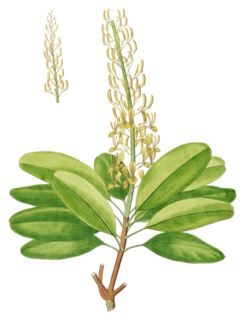The Agag gerbil is distributed mainly in southern Mauritania to northern Nigeria and Sudan. IUCN lists the junior synonyms Gerbillus cosensi and G. dalloni as critically endangered.

Schinopsis is a genus of South American trees in the family Anacardiaceae, also known by the common names quebracho, quebracho colorado and red quebracho. In Brazil it is known as baraúna or braúna.
Adelphia is a genus in the Malpighiaceae, a family of about 75 genera of flowering plants in the order Malpighiales. Adelphia comprises four species of woody vines native to the West Indies, Mesoamerica, and western South America.
Alicia is a genus in the Malpighiaceae, a family of about 75 genera of flowering plants in the order Malpighiales. Alicia comprises 2 species of woody vines widespread in South America.
Malpighiodes is a genus in the Malpighiaceae, a family of about 75 genera of flowering plants in the order Malpighiales. Malpighiodes comprises 4 species of woody vines native to northern South America.

Kemp's gerbil is a species of rodent. Mammal Species of the World considers G. kempi and G. gambianus to be synonyms, however the IUCN has assessed each taxon as were they different species.

The gracile naked-tailed shrew is a species of mammal in the family Soricidae. It is found in Burundi, Gabon, Kenya, and Uganda. Its natural habitat is swamps.

The Ugandan lowland shrew is a species of mammal in the family Soricidae. It is found in Kenya and Uganda. Its natural habitats are subtropical or tropical swamps and subtropical or tropical moist montane forest. It is threatened by habitat loss.

The Mount Cameroon forest shrew is a species of mammal in the family Soricidae endemic to Cameroon. Its natural habitat is subtropical or tropical moist montane forests.

Helicia is a genus of 110 species of trees and shrubs, constituting part of the plant family Proteaceae. They grow naturally in rainforests throughout tropical South and Southeast Asia, including India, Sri Lanka, Indochina, Peninsular Malaysia to New Guinea and as far south as New South Wales.
Schinopsis haenkeana is a species of plant in the family Anacardiaceae. It is found in Argentina and Bolivia. Its vernacular names include quebracho blanco, horco quebracho.

Vochysia is a genus of plant in the family Vochysiaceae. It contains the following species, among many others:

Thaddeus Xaverius Peregrinus Haenke was a botanist who participated in the Malaspina Expedition, exploring a significant portion of the Pacific basin including the coasts of North and South America, Australia, the Philippines, New Zealand, and the Marianas. His collections of botanical specimens were the basis for the initial scientific descriptions of many plants in these regions, particularly South America and the Philippines. His extensive botanical work and far-ranging travel have prompted some to liken him to a "Czech Humboldt", named after Alexander von Humboldt, who made himself familiar with some of Haenke's findings before embarking on his journey to the Americas in 1799.
Christianella is a genus in the Malpighiaceae, a family of about 75 genera of flowering plants in the order Malpighiales. Christianella comprises 5 species of woody vines and shrubby habit occurring in forests, roadside thickets, and shrubby savannas in southeastern Mexico, Central America, and South America.

The World's 25 Most Endangered Primates is a list of highly endangered primate species selected and published by the International Union for Conservation of Nature (IUCN) Species Survival Commission (SSC) Primate Specialist Group (PSG), the International Primatological Society (IPS), Global Wildlife Conservation (GWC), and Bristol Zoological Society (BZS). The IUCN/SSC PSG worked with Conservation International (CI) to start the list in 2000, but in 2002, during the 19th Congress of the International Primatological Society, primatologists reviewed and debated the list, resulting in the 2002–2004 revision and the endorsement of the IPS. The publication was a joint project between the three conservation organizations until the 2012–2014 list when BZS was added as a publisher. The 2018–2020 list was the first time Conservation International was not among the publishers, replaced instead by GWC. The list has been revised every two years following the biannual Congress of the IPS. Starting with the 2004–2006 report, the title changed to "Primates in Peril: The World's 25 Most Endangered Primates". That same year, the list began to provide information about each species, including their conservation status and the threats they face in the wild. The species text is written in collaboration with experts from the field, with 60 people contributing to the 2006–2008 report and 85 people contributing to the 2008–2010 report. The 2004–2006 and 2006–2008 reports were published in the IUCN/SSC PSG journal Primate Conservation,, since then they have been published as independent publications.

Ephedra breana is a species of Ephedra growing from northwest Argentina through to Chile and Bolivia.










